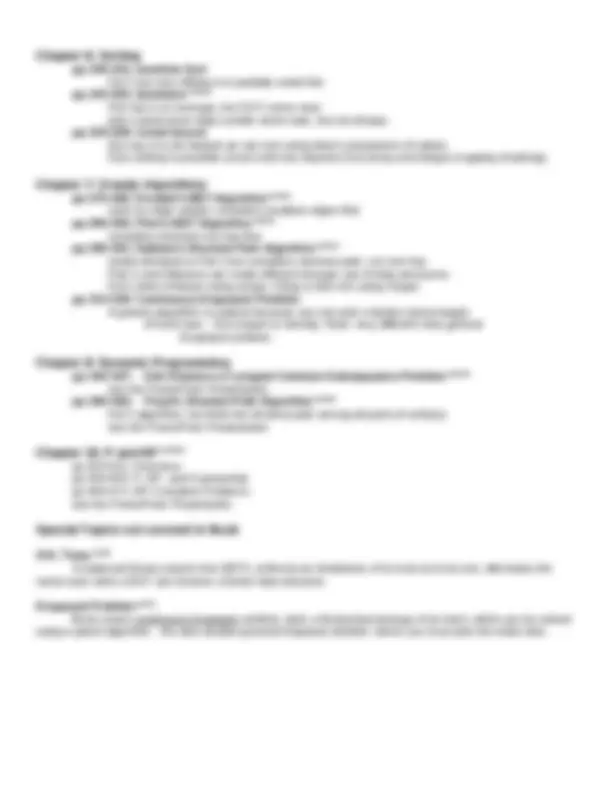



Study with the several resources on Docsity

Earn points by helping other students or get them with a premium plan


Prepare for your exams
Study with the several resources on Docsity

Earn points to download
Earn points by helping other students or get them with a premium plan
Community
Ask the community for help and clear up your study doubts
Discover the best universities in your country according to Docsity users
Free resources
Download our free guides on studying techniques, anxiety management strategies, and thesis advice from Docsity tutors
A review guide for the final exam of a university course on analysis of algorithms. It covers various topics including properties of algorithms, pseudocode, math review, order notation, recurrence relations, graphs, data structures, divide and conquer, sorting, greedy algorithms, and dynamic programming. It also mentions special topics not covered in the book, such as avl trees and the knapsack problem.
Typology: Exams
1 / 2

This page cannot be seen from the preview
Don't miss anything!


pp 1-2: 7 Properties of Algorithms ***** Don’t just memorize them; be able to show and identify examples pp 4-9: Pseudocode Imprecise but makes writing complex algorithms easier
pp 18: Polynomials Remember, largest exponents dominates the growth rate pp 24-26: Logarithms The base is just a constant log 2 n = (loglog 4 n) Log grows very slowly n log n << n^2 pp 32-37: Induction Proofs Used to prove the correctness of algorithms and running time
pp 41-43: Order Notation - Memorize the definitions of Big-O, Ω, and ***** Big-O is upper bound, Ω is lower is lower bound pp 44-49: Examples pp 50-51: Common growth functions
pp 55-56: Simple Examples pp 56-58: How to solve pp 59-60: Main Recurrence Theorem (logBig-Hammer) Review Exam 1 *****
pp 68-70: Overview (review only) pp 70-71: Adjacency Matrix for graphs Also, consider adjacency list as alternative pp 71-76: Complete and bipartite graphs; paths, cycles, and other terminology pp 76-81: Hamiltonian and Euler Cycles
pp 101-109: Stacks & Queues (review only) pp 111-117: Linked Lists Linked Lists vs. Arrays ***** Adjacency Lists for graphs pp 120-130: Binary Search Trees (logBST) Linked-list type structure that support efficient insertion and search O(log n) search on average; O(n) search in worst case Flaws are the motivation for balanced trees (AVL trees) and Heaps pp 133-147: Binary Heaps, Priority Queues, Heapsort Heaps are the best structure for Priority queues: O(1) insertion (average case);O(log n) find min (worst case)
pp 219-222: Merge Sort ***** Know the merge function and recursive mergesort function Divide and conquer, bottom up recursion; O(n log n) in the worst case pp 226-231: Closest-pair Problem O(n^2 ) pairs to consider, yet Divide & Conquer yields O(n log n) algorithm see the PowerPoint Presentation
pp 239-241: Insertion Sort O(n^2 ) but very efficient on partially sorted list pp 243-252: Quicksort ***** O(n log n) on average, but O(n^2 ) worst case pick a good pivot helps avoids worst case, but not always pp 254-259: Lower-bound Ω(n log n) is the fastest we can sort using direct comparison of values O(n) sorting is possible (count sort) but requires O(n) array and integer mapping (hashing).
pp 275-282: Kruskal’s MST Algorithm ***** sorts by edge weight; considers smallest edges first pp 284-293: Prim’s MST Algorithm ***** considers shortest one hop first pp 295-301: Dijkstra’s Shortest Path Algorithm ***** nearly identical to Prim’s but considers shortest path, not one hop Prim’s and Dijkstra’s are made efficient through use of data structures: O(1) vertex lookups using arrays, O(log n) find min using Heaps pp 313-318: Continuous Knapsack Problem A greedy algorithm is optimal because you can pick a faction (percentage) of each item. Sort based on density. Note: very different than general Knapsack problem.
pp 342-347: Edit Distance or Longest Common Subsequence Problem ***** see the PowerPoint Presentation pp 350-355: Floyd’s Shortest Path Algorithm ***** O(n^3 ) algorithm; but finds the shortest path among all pairs of vertices. see the PowerPoint Presentation
pp 429-431: Overview pp 458-459: P, NP, and Exponential pp 466-473: NP-Complete Problems see the PowerPoint Presentation
AVL Trees **** A balanced binary search tree (BST); enforces an imbalance of at most at most one; eliminates the worst case when a BST can become a linear data structure. Knapsack Problem **** Book covers continuous knapsack problem (pick a fraction/percentage of an item) which can be solved using a greed algorithm. We also studied general knapsack problem where you must pick the entire item.